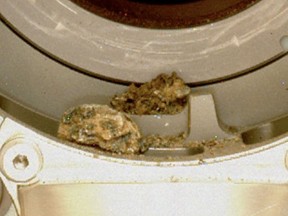The rover halted its collection process late last month after hitting a snag while attempting to core a rock

Article content
The hostile Red Planet seems to be testing whether NASA’s Perseverance rover will live up to its name. The rover had drilled and gathered its sixth sample of Martian rock late last month when some pesky pebbles snarled the titanium carousel used for collection, restricting the movement of its 7 foot tall robotic arm.
Advertisement
This advertisement has not loaded yet, but your article continues below.
Article content
“I recently captured my sixth rock core and have encountered a new challenge. Seems some pebble-sized debris is obstructing my robotic arm from handing off the tube for sealing/storage,” said the Twitter account of the car-sized robot that could.
“More images and data to come. #SamplingMars takes perseverance,” its mission team members wrote last Friday.
At first, the process was going smoothly. Perseverance stowed away samples from a Martian rock outcrop nicknamed Issole. Then, the rover halted its collection process after hitting a snag while attempting to core the sample.
-
NASA’s Perseverance rover makes historic landing on Mars after ‘seven minutes of terror’
-
NASA flies a helicopter on Mars: Ingenuity captures its shadow on the ground below
Advertisement
This advertisement has not loaded yet, but your article continues below.
Article content
“During the transfer of the bit that contains the sample into the rover’s bit carousel (which stores bits and passes tubes to the tube processing hardware inside the rover), our sensors indicated an anomaly,” wrote Louise Jandura, chief engineer for sampling and caching, in a blog post last Friday.
In update posted yesterday, Jennifer Trosper, Project Manager at NASA’s Jet Propulsion Laboratory said the team has come up with a viable, if novel, solution, starting by returning contents of Sample Tube 261 back to the planet:
“We sent commands up yesterday, and later on today the rover’s robotic arm will simply point the open end of the sample tube toward the surface of Mars and let gravity do the rest.
“Although this scenario was never designed or planned for prior to launch, it turns out dumping a core from an open tube is a fairly straightforward process.”
Advertisement
This advertisement has not loaded yet, but your article continues below.
Article content
Commands are being sent up later today to rotate the bit carousel, at first slow then a bit faster, said the post, adding the process should be executed over the weekend.
Perseverance could remain on Issole for a few more weeks depending on if the scientists decide to resample it.
NASA got a sense of what the anomaly last week when Perseverance’s mission team told the rover to separate the drill bit and the sample from the carousel. Images sent back showed what we now know: the cached samples fell out, which kept the drill bit from fitting neatly into the carousel.
Advertisement
This advertisement has not loaded yet, but your article continues below.
Article content
“These most recent downlinked images confirm that inside the bit carousel there are a few pieces of pebble-sized debris,” Jandura wrote. The team suspects some rocks and regolith (rock bits and dust) fell out from the sample tube during the collection process.
However, it wasn’t time to ponder existential questions about the rover. The designers of the carousel had prepared for this possibility, wrote Jandura, but they want to take all the time that’s necessary to ensure the pebbles can “exit in a controlled and orderly fashion”
While the Perseverance team is taking things slow and assessing, their rover is taking in the scenery.
Advertisement
This advertisement has not loaded yet, but your article continues below.
Article content
“By end of week, we should be ready to attempt removing the pebbles in my bit carousel so I can get back to #SamplingMars. For now, I’m studying the rocks around me in more detail,” the team tweeted on Jan 11.
The samples are supposed to be brought to earth in the coming decade. The rocks of Seitah are especially noteworthy for the history it holds, according to a NASA blog post from November:
“By studying the directions that the layers tilted, we determined that the rocks of Séítah are likely the most ancient rocks exposed in all of Jezero crater.
Séítah therefore represents the beginning of the accessible geologic record and offers a once-in-a-mission opportunity to explore the full breadth of landscape evolution,” the post noted.
Advertisement
This advertisement has not loaded yet, but your article continues below.
Credit: Source link
























